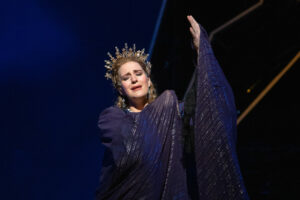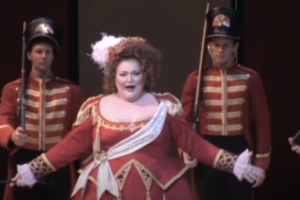

You remember the line from Six Degrees of Separation about Cats? That Aeschylus did not invent the theater for it to end up a bunch of chorus kids wondering which of them is going to kitty cat heaven? Well I’m comfortable saying that Beaumarchais, Da Ponte, and Mozart did not invent what is essentially our template for comic opera for it to end up a bunch of chorus kids mugging like high schoolers in a production of Noises Off, and yet that’s the headachey product you get about 80 percent of the time at Figaro. It is not, however, what Robin Guarino and her very accomplished ensemble cast have come up with in this summer’s revival in San Francisco.
One of the few pleasure of middle age is having seen the birth of a career in full bloom. If anything, I underestimated Lisette Oropesa the year she was a winner at the Met auditions. Her musicality was certain, but it was impossible in that context to foresee what an easy comic presence she would have. It is an unspeakable relief that at no moment was I in danger of having to describe her Susanna, brightly and freely intoned, as perky.
Her reading instead relied on the character’s intelligence and on Oropesa’s natural manner of comportment. This might have left things lopsided had not she had such an excellent foil in Philippe Sly’s Figaro. Sly could easily enough rest on the youthful beauty of his tone or on his slightly goofy hotness, but as early as “Se vuol ballare” he announced his intention not to, by singing instead with wit and spontaneity. His brief turn in Partenope last year and clips on the internet confirm it: Sly is the genuine article.
I might pause to say that I expected less in the first moments of this revival. As fine and novel as it is to have an unstaged overture these days, the curtain rose, after an account of said overture like any other (for it is the sole purpose of that music, divine as it is, in its 20 millionth playing to allow reviewers time to decide between two possible adjectives: effervescent or… well, no, there’s just the one) on an unassuming, traditional set. I won’t pretend I’m not biased a little in favor of something more risky in this work in particular.
The thing about this production, though, is that, by instinct or direction, everyone but the purely buffo characters acts and interacts like a human being. Nadine Sierra, long of breath and with here and there the slightly hooty tone of mid-century Viennese sopranos, regarded the Count with enough mixed feelings to make the final moments of the opera plausible. If she seemed a little less worldly than many proponents, a question highlighted by her Susanna-ish timbre, the director’s assertions of who these multifaceted characters might be to each other seemed to make sense of it.

Mezzo Kate Lindsey sings without that last degree of vocal individuality that separates the female boys from the female men, but it’s a warm and appealing sound and her embodiment of a gawky, horny kid was real enough that my companion, a first-time opera-goer, whispered at first curtain “that’s a woman playing Cherubino, right?” Lindsey, like the rest of the cast, was supported by Patrick Summers in a judicious use of ornamentation. This remains a matter of taste in Mozart, but nobody went all Proch Variations on anything so why complain? Summers was also attentive to the disparate voice sizes among the cast.

I rarely tear up at the opera but for a moment, when the Almavivas had patched things up and the Count shooks hands with Figaro, I did. An odd little gesture and, for all I know, not an uncommon one, but at just that moment, it was a confirmation of the work’s humanity.
Le nozze di Figaro plays seven more times, and then in perpetuity about every four years.
Photos ©Cory Weaver/San Francisco Opera

























Comments